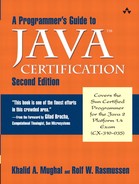7. Nested Classes and Interfaces
| 7.1 |
// Filename: Exercise3.java
interface Function {
public int evaluate(int arg);
}
class Half implements Function {
public int evaluate(int arg) {
return arg/2;
}
}
class Print implements Function {
public int evaluate(int arg) {
System.out.println(arg);
return arg;
}
}
public class Exercise3 {
/* Inner class that applies the function, prints the value, and
returns the result. */
static class PrintFunc extends Print {
PrintFunc(Function f) {
func = f;
}
Function func;
public int evaluate(int arg) {
return super.evaluate(func.evaluate(arg));
}
}
// Inner class that just returns the argument unchanged.
/* Use this when you want a PrintFunc object to print
the argument as-is. */
static class NoOpFunc implements Function {
public int evaluate(int arg) {
return arg;
}
}
public static void main(String[] args) {
// Create array with values 1 .. 10
int[] myArr = new int[10];
for (int i=0; i<10;) myArr[i] = ++i;
// Print array without modification
applyFunctionToArray(myArr, new PrintFunc(new NoOpFunc()));
// Print halved values
applyFunctionToArray(myArr, new PrintFunc(new Half()));
}
public static int[] applyFunctionToArray(int[] arrIn, Function func) {
int length = arrIn.length;
int[] arrOut = new int[length];
for (int i=0; i< length; i++)
arrOut[i] = func.evaluate(arrIn[i]);
return arrOut;
}
}
The output when run is the same as in Exercise 6.2. |
..................Content has been hidden....................
You can't read the all page of ebook, please click here login for view all page.
